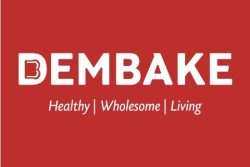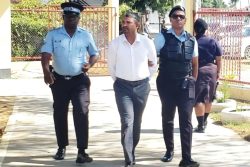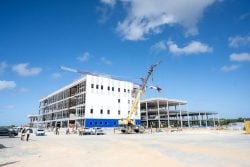There are 17 sites across the ten administrative regions of Guyana, providing HIV care, treatment and support, Minister of Health Dr Leslie Ramsammy said on Tuesday, in response to a recent release from the National AIDS Committee (NAC), which listed several impediments in the effective delivery of these services.
Ramsammy said the release, published in Monday’s edition of the Stabroek News, included several misrepresentations and was an unfair reflection of the status of the National AIDS Programme in Guyana. Citing an assertion that people have limited access to treatment and care, he said it “is a statement that maliciously fails to acknowledge the tremendous efforts of the National AIDS Programme in creating a treatment and care service that provides convenient access to persons wherever they live.”
The NAC issued a release following a recent workshop which it said drew 40 participants from nine of the country’s ten administrative regions. The release said the “universal access” review workshop, held on February 4 at the Methodist Outreach Centre for Persons Living with HIV and AIDS (PLWHA), identified issues such as mistakes in dispensing anti-retrovirals (ARVs), a shortage of trained doctors and nurses to work along with PLWHA, difficulty in recruiting home-based care providers, and religion in certain instances being a primary driver of stigma, which still exists.
However, Ramsammy, in a detailed response, said treatment and care services are adequately distributed throughout the ten administrative regions of Guyana. He said that in 2002 there was one site offering anti-retroviral therapy in Georgetown but at the end of 2010 there were 17 sites providing care, treatment and support services, catering for persons in all ten regions.
According to the minister, the Guyana-Cuba partnership has enabled the ministry to have access to and to employ more doctors than at any other time in our history.
The NAC had said that there was a shortage of trained doctors and nurses to work along with PLWHA. Concern was also raised over there not being an understudy to the UN volunteer doctor (whose contract may soon be completed). The UN volunteer is solely responsible for treatment, care and support in the interior regions, where he makes quarterly visits.
According to the release, “there is a widely accepted consensus that the Cuban doctors do not know how to deal with HIV patients and do not seem to want to work with them. The same can be said about certain Guyanese nurses who also do not want to work with HIV and AIDS patients.”
But Ramsammy said his ministry has trained 14 new doctors in HIV/AIDS management and these have now been added to the treatment sites throughout the regions, expanding the technical capacity of the public health sector to clinically manage persons living with HIV/AIDS. He said these physicians are now providing care and treatment services. In addition to the doctors, nurses, medex and other support staff present in the regions, the ministry provides HIV/AIDS-related services to the hinterland by way of an expert mobile team which visits each region regularly to treat patients and support the resident medical staff, Ramsammy said.
However, he admitted that there is still room for improvement and his ministry acknowledged that there are still various aspects of the treatment and care programme which must be improved. “But the fact is the ministry has made significant strides in the expansion of the services to all administrative regions. We must be blunt, however, in saying that treatment and care services will never be found in every village. Even countries with greater financial and human resources capacity than Guyana cannot provide such services within walking distance of everyone,” he said.
He asserted too that the NAC is wrong when it concludes that the medicine regimen in Guyana is inappropriate. He said the ministry continues to strive for the highest quality of care for persons, including, in this case, the most superior regimen of choice. “The regimen selected for use in Guyana is founded on evidence and is proven to be one of the most efficacious first line regimens in use around the world, in developed and developing countries. The selection was done through extensive consultations with Guyanese and international experts,” he added.
The minister boasted that the World Health Organization’s (WHO) recent revision of HIV/AIDS Treatment Guidelines (2010) is now recommending the exact treatment regimen in use in Guyana as the first choice for patients needing ARVs.
With regard to the release stating that health care workers do not spend enough time discussing side effects of ARVs and the importance of diet, the minister said this statement “is unfair to the many dedicated health workers who have tried their best to ensure their clients are provided with all the information they need to become part of their own health care.” He added, “The fact is that there are always situations, wherever one goes in the world, where spending more counseling time with patients would contribute to improving the quality of service. Yet, counseling patients in terms of their medication and their nutrition and self-care represents an integral part of the care and treatment program of the Ministry of Health.” In fact, he noted, the ministry conducted a client satisfaction survey among patients attending the HIV treatment sites and the results showed that patients are very satisfied with the services. The survey was done by an independent team. He said the survey report is available from NAPS and should soon be available on the Ministry of Health website.
As regards ARVs, adherence and related issues, the minister pointed out that patients are required to attend three counseling sessions prior to the initiation of ARV therapy. The sessions focus on factors relating to their medication use such as side effects, dosage and timing, nutrition, drug-drug and drug-food interaction. There is further reinforcement at each visit on issues of adherence, disclosure and positive prevention. These are essential components of provider-patient interaction. In dispensing of medication, labels and direction are clearly stated so as to facilitate patient use. Caregivers and treatment support partners are educated in these various issues, the minister said.
Meantime, the minister said the Home-Based Care Programme was established in 2005 and is currently being provided at 11 treatment sites by trained nurses. Additional support is offered through NGOs and faith-based organizations, which have 75 caregivers distributed within the regions. To date, he said, there have been 1,035 persons trained in accordance with the National Home-Based Care Guidelines. The minister pointed out that home-based care services is based onindividual consent.
And according to Ramsammy HIV diagnosis is an area all Guyana can be proud of. “A citizen can be tested for HIV almost everywhere in Guyana. It is free and in the last three years, more than 300,000 HIV tests have been done in Guyana, in all ten regions. Few countries can boast of better access to HIV testing than Guyana. This is a fact that no one can dispute,” the minister asserted.
He said laboratory services for the clinical management of PLWH continue to be a hallmark of the HIV programme.
Ramsammy said the provision of public assistance is supported by his ministry. He said a uniform standard operating criteria is utilized throughout the regions. As a result, the use of the official stamp is to support monitoring and financial auditing. This promotes transparency and accountability. The provision of food hampers follow an eligibility criterion and is provided to only qualified recipients.
The NAC had stated that patients were concerned that the stamps on the vouchers make their positive status known to postal workers and as such contributes to stigma and discrimination.
Further, Ramsammy said, there are 125 peer educators in regions 1, 7, 8 and 9 who work with organizations within the regions such as schools, religious organizations and civic bodies. He said the resources to conduct these activities are available. However, careful planning is required so as to effectively utilize these resources.




